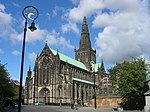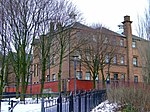James White (1812–1884)
1812 births1884 deaths19th-century Scottish businesspeople19th-century Scottish lawyersAlumni of the University of Glasgow ... and 4 more
People educated at the High School of GlasgowPeople from DumbartonPeople from RutherglenUse British English from October 2017

James White (1812–1884) was a Scottish lawyer, businessman and chemicals manufacturer. In 1890 he was honoured posthumously with a statue in Glasgow’s Cathedral Square, designed by John Mossman (although he died before its completion) and sculpted by Frank Leslie. It has been designated a Category 'B' listed building by Historic Scotland.
Excerpt from the Wikipedia article James White (1812–1884) (License: CC BY-SA 3.0, Authors, Images).James White (1812–1884)
Cathedral Precinct, Glasgow Townhead
Geographical coordinates (GPS) Address Nearby Places Show on map
Geographical coordinates (GPS)
| Latitude | Longitude |
|---|---|
| N 55.862783 ° | E -4.236484 ° |
Address
Cathedral Precinct
Cathedral Precinct
G4 0QZ Glasgow, Townhead
Scotland, United Kingdom
Open on Google Maps









